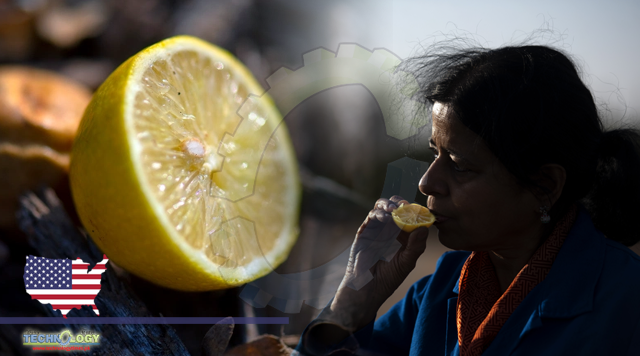Tucked behind twists and turns of dusty roads and acres of groves at UC Riverside’s agriculture research station are hybrid trees with golf-ball-size fruit that offer hope in the fight against a citrus greening disease threatening California’s iconic citrus industry.

By DAVID DOWNEY
Since 2013, UCR scientists have been trying to breed citrus varieties that resist Huanglongbing or HLB — also known as citrus greening disease — which has ravaged Florida oranges and spread widely among Inland Empire backyard trees.
At the same time, scientists are trying to develop fruit with a taste that appeals to consumer palates.
UC Riverside botanist Chandrika Ramadugu walks rows of hybrid citrus she and her team have developed on the Riverside campus Monday, Jan. 4, 2021.
Striking the right balance will be a significant challenge, said Chandrika Ramadugu, a UCR botanist leading the project.
“We hope we get lucky,” Ramadugu said Monday, Jan. 4.
It’s a project that’s expected to take years to bear fruit. But it is hoped the effort will pay off in the long run by delivering to the marketplace a citrus product that can withstand the relentless attack of the deadly tree disease.
“HLB is caused by bacteria, so many people are trying to control it with antimicrobial sprays,” Ramadugu said in a news release. “We want to incorporate resistance into the citrus trees themselves through breeding, to provide a more sustainable solution.”
The UCR-led effort — done in partnership with researchers from Texas A&M University, the University of Florida, Washington State University and the U.S. Department of Agriculture — recently received a $4.67 million grant from the National Institute of Food and Agriculture.
Mikeal Roose, professor of genetics in UCR’s Department of Botany and Plant Sciences, said the money will be used to test hybrid citrus developed to date.
The team is studying hybrids’ genetic makeup, Ramadugu said, to identify genes that are associated with disease resistance.
Citrus greening disease has ravaged citrus around the world and wiped out 75% of Florida’s once-abundant orange crop, a UC Davis report said.
A tiny bug, the aphid-like Asian citrus psyllid, spreads the disease. Leaves of infected trees become mottled and misshapen, and their fruit is bitter. The disease can kill a citrus tree in as few as five years, and there is no known cure, according to a UC Agriculture & Natural Resources website.
A spokesman for the Los Angeles County agricultural commissioner has said that the first infected fruit tree in California was discovered in 2012 in the front yard of a Hacienda Heights home.
The alarming rapid spread prompted the covering of Riverside’s parent navel orange tree, creation of a sweeping Southern California quarantine area and a UCR study examining how the disease attacks fruit trees.
Steve Lyle, spokesman for the state Department of Food and Agriculture, said in an email Tuesday, Jan. 5, that the disease has infected 2,242 residential citrus trees in Riverside, San Bernardino, Los Angeles and Orange counties.
So far, no infected trees have been found in commercial citrus groves, Lyle said.
State and local officials and scientists call the disease a serious threat to California’s $2 billion-a-year citrus industry.
And, so, Lyle wrote, state agriculture officials welcome the efforts of Ramadugu’s team “to develop commercially viable citrus varieties that have resistance or tolerance to Huanglongbing.”
About eight years ago, Ramadugu said her team launched the project by breeding mandarin orange trees with Australian relatives of citrus that tend not to succumb to citrus greening disease.
“We chose these because you can cross them with citrus,” she said.
More than 10,000 plant crosses have been bred to date, Ramadugu said. She said 350 hybrid trees are growing at the university research station and thousands of seedlings are growing in a greenhouse.
“Breeding is a numbers game,” she said.
Team members are trying to find just the right mix of genes that will deliver a fruit both delicious and disease free — and big enough to attract grocery-store buyers, Ramagadu said.
The Australian finger lime, one of the citrus cousins used in the breeding process, for example, tends to have a sour taste, Ramadugu said.
Roose, the genetics professor, said the Australian varieties also tend to produce small fruit.
“The biggest one is maybe the size of a golf ball,” he said.
That’s why the team is breeding for taste and size, while trying to avoid compromising ability to resist the disease.
“It’s hard to predict, in advance, how many generations it is going to take to get to an end product that people are going to want to eat,” Roose said.
It typically takes years before new trees bear fruit, he said. So the team is working with Sean Cutler, a UCR professor of plant cell biology, to accelerate that process in the greenhouse, the news release stated.
“In one sense, it’s easier to achieve that kind of balance over a longer period of time,” Roose said. “The bigger challenge is to get there quickly.”
Originally published at The press enterprise